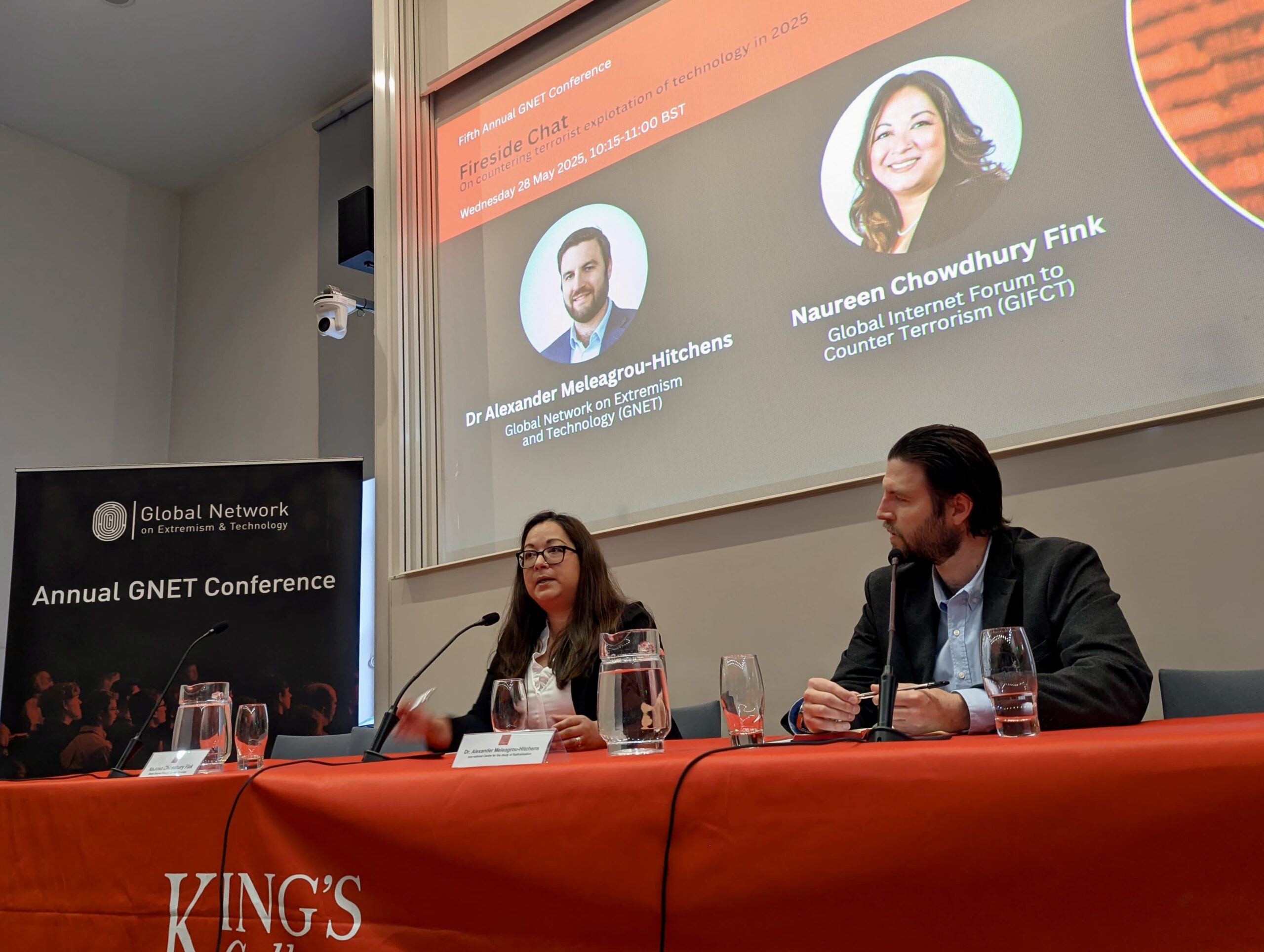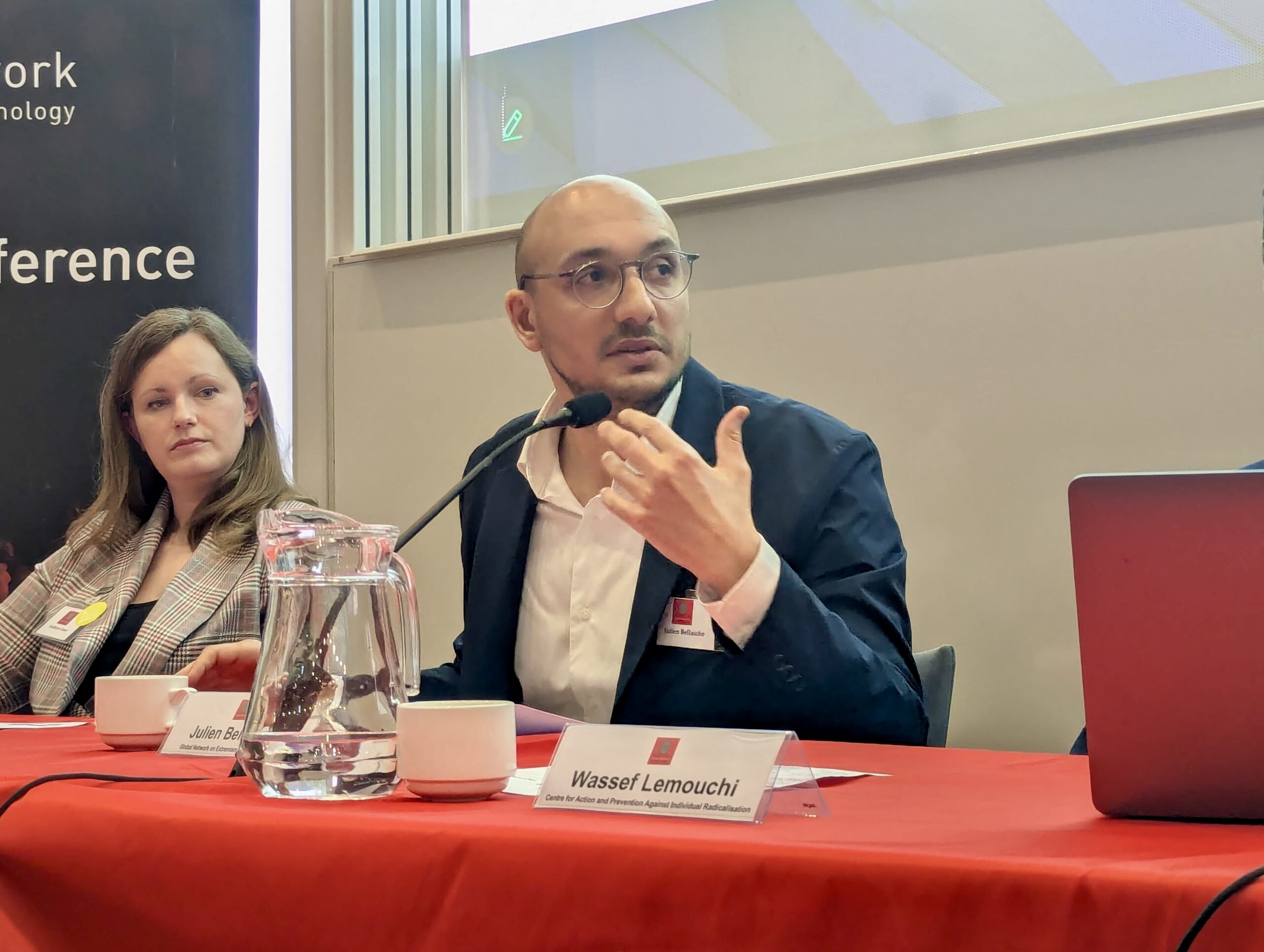The Global Internet Forum to Counter Terrorism (GIFCT) was pleased to participate in the Fifth Annual Conference of its academic research arm, the Global Network on Extremism and Technology (GNET). The event, held on May 28th at King’s College London, brought together representatives from academia, civil society, industry, and government to examine the evolving relationship between terrorism, violent extremism, and technology.
Panelists presented findings from research and lessons learned from practice, and highlighted a number of themes, including:
- The need to adapt rapidly to evolving trends: Radicalization online is evolving across platforms and narratives, with violent extremists using subtle, persistent, and evasive tactics to engage and mobilize users, often on an increasingly condensed timeline.
- The importance of improving collective readiness: The nature of emerging technologies necessitates enhancing the abilities of industry and practitioners to improve detection and response systems, accounting for the speed, complexity, and convergence of these technologies, as well as cross-platform exchanges.
- The critical role of cross-sector collaboration: Collaboration and coordination among numerous sectors, including tech, public health, nonprofit, and relevant practitioners, remains critical to developing more effective strategies to address emerging threats.

Fireside Chat with Naureen Chowdhury Fink and Dr. Alexander Meleagrou-Hitchens
Fireside Chat
Following opening remarks from Julien Bellaiche, the Research Director of GNET, the event began with a fireside chat between GIFCT Executive Director Naureen Chowdhury Fink and Dr. Alexander Meleagrou-Hitchens, Co-Director of the International Centre for the Study of Radicalisation and Principal Investigator of GNET. The discussion highlighted the evolution of GIFCT and the importance of research in supporting GIFCT members and stakeholders to adapt to the contemporary threat landscape, underpinning the critical role of GNET.
“Our expanding community of practice and the technical tools, resources, and information GIFCT provides to its member platforms are informed by engagement with a multi-stakeholder audience from across industry, government, civil society, and academia. GNET, the research arm of GIFCT, plays a critical role in supporting our members and the broader tech and counter terrorism communities with timely and relevant reports and insights.
As the threat landscape continues to evolve, cross-sector collaboration will become even more important to address the uncertainties of “borderline” content and TVEC with no clear affiliations; the targeting and radicalization of youth and minors; and the convergence of emerging technologies to create new threat vectors. We’re thankful for the opportunity to participate, once again, in the annual GNET conference and the important dialogue & exchanges needed to counter threats both on and offline.” – Naureen Chowdhury Fink, GIFCT

Extremism and Emerging Technology: The Risks and Realities of Innovation panel
Panel 1: Extremism and Emerging Technology: The Risks and Realities of Innovation
The first panel, chaired by GIFCT Senior Director of Memberships and Programs Dr. Erin Saltman, examined how rapid advances in technology are reshaping the threat landscape, and how cross-sector collaboration and imaginative problem solving are essential to building resilience in online spaces. Dr. Yannick Veilleux-Lepage opened the discussions by warning that the real danger lies not in individual technologies, but in their convergence—where blind spots form and new threats emerge.
“How multiple technologies converge to create an entirely new threat vector is a blind spot that needs further analysis – this goes both for technologies that we already know can be dangerous, as well as those that we see as benign. If we want to anticipate how terrorists and violent extremists are exploiting emerging technologies and the convergence of technologies, we need to think about creating new data pipelines and new opportunities for collaboration, and be more imaginative in solutions.” – Dr. Yannick Veilleux-Lepage, Royal Military College of Canada
Veilleux-Lepage was followed by Mona Thakkar, who provided a detailed look at how specific technologies are being exploited to finance terrorism through the use of cryptocurrency bots, video guides, and formal banking channels, often disguising fundraising as humanitarian aid to avoid detection. The panel continued with an overview of AI threats and trends, as discussed by Dr. Marten Risius, who emphasized the long-term societal risks of AI and urged for a deeper analysis of these diffuse impacts—work that GIFCT continues to facilitate through its “Artificial Intelligence: Threats and Opportunities” Working Group. The panel concluded with a look at how Natural Language Processing tools like Ricardo Cabral Penteado’s BR-ECHO are being used to detect violent extremist content in Brazilian Portuguese by analyzing euphemisms, slang, and coded language—critical methods for identifying and moderating terrorist and violent extremist content online.

Julien Bellaiche, GNET
Panel 2: The Researcher’s Toolkit: Resources for P/CVE Practitioners
Moderated by GIFCT Senior Membership and Programming Associate Micalie Hunt, the second panel turned to the practical tools available to those on the frontlines of preventing and researching violent extremism. Kathryn Grant of TikTok opened the session with an overview of the platform’s research offerings, including guidance for academics seeking access to TikTok’s public data through its Research API and Virtual Compute Environment. Expanding on the theme of accessible resources, Julien Bellaiche of GNET introduced the Repository of Extremist Aligned Documents (READ), a free database of over 2,200 far-right/ideologically motivated violent extremism (IMVE) documents and primary sources designed to support researchers and practitioners. Closing the panel, Wassef Lemouchi showcased a new AI tool developed to assist families and frontline professionals, offering legal, psychological, and practical support for those confronting radicalization in their communities.
“READ was designed for professionals in the field working on countering terrorism and violent extremism. It democratises access to sensitive materials within the community of research professionals, preserves the psychological well-being of researchers by minimizing the time spent in the TVE online ecosystem, and ensures that these resources are preserved and archived in a secure digital repository.” – Julien Bellaiche, GNET

Fifth Annual GNET Conference
Panel 3: Multi-Media Radicalisation and the Online-Offline Extremism Nexus
Chaired by Dr. Alexander Meleagrou-Hitchens, the final panel explored how digital spaces and behaviors are creating new pathways to radicalization. Dr. Ryan Scrivens opened with a focus on violent right-wing extremists, emphasizing the need to monitor low-profile, persistent online posters whose behavior may signal a move toward mobilization. Building on the theme of subtle radicalization cues, Clara Jammot examined violent masculinist extremism, noting how blurred ideological lines and fragmented narratives lower entry barriers and challenge definitions of violent extremist content. At the intersection of gender, violent extremism, and technology, Dr. Jessica White shared findings from a global study by the Extremism and Gaming Research Network, emphasizing the need for gendered, intersectional moderation strategies in gaming spaces where radicalization can take root.
“Billions of people play games and have a very positive experience, but it is a community space that requires our attention. The social element of gaming is a powerful thing, and gaming identities can be more real to people than their offline or “real-life” identities. As practitioners seeking to counter online harms, we must understand the relationship between these identities and their linkages to radicalization.” – Dr. Jessica White, RUSI
The panel closed with Milo Comerford, who presented sobering case studies on how violent extremists exploit platform gaps to groom, recruit, and direct minors toward violence—a core focus of GIFCT’s “Addressing Youth Radicalization and Mobilization” Working Group. Gaming, gender, youth, and AI are key focus areas for GIFCT. The “Gaming Community of Practice” Working Group recently explored ways to improve online gaming safety, publishing a resource list, framework, and best practices reports informed by Dr. White and other experts, while GIFCT Executive Director Naureen Chowdhury Fink also explored the link between gender, technology, and terrorism in her recent piece, The Instrumentalization of Gendered Narratives in the Search for Legitimacy of Terror Groups.
Learn More About GNET and Contribute
Funded and supported by GIFCT, and convened and led by the Centre for Statecraft and National Security (CSNS), a globally renowned academic research center based within the Department of War Studies at King’s College London, GNET brings together an international consortium of leading academic institutions and experts to provide GIFCT members and partners with research and analysis on emerging threats and trends, including ongoing crises and conflicts, and to connect them to a global network of experts and scholars.
Are you interested in the nexus between violent extremism and technology? If you have an idea for a timely, evidence-based report about the groups, individuals, movements, or trends shaping the violent extremist landscape today, consider submitting an outline.


